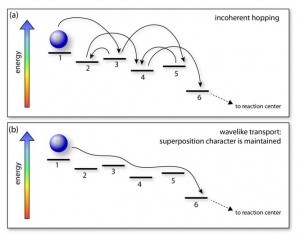Quantum mechanical predictions reduce to those of classical mechanics in the macroscopic world; otherwise absurd situations would result such as Schrödinger’s cat being both dead and alive in the box. But does quantum mechanics play a specific role in the functions of complex biological systems?
An advance in the study of the photosynthetic light-harvesting process demonstrated that the electronic energy transfer might not follow the classical hopping mechanism but involve quantum-coherent energy transfer. This discovery relied on the development of new ultrafast spectroscopic techniques and these form the basis of this Tutorial Review by Elisabetta Collini from the Department of Chemical Sciences at the University of Padova.
The state-of-the-art techniques, and their limitations, for the detection of quantum-coherent energy transfer in light-harvesting complexes are discussed. They include; pump-probe anisotropy, two-time anisotropy decay and 2D photon echo techniques.
Although the review focuses on photosynthetic energy transfer, quantum effects have been posited in other processes including; olfaction, magnetic sensing and even consciousness. The extent to which quantum mechanics affect these processes in physiological conditions has often been seen as a negligible curiosity.
This Tutorial Review explores the techniques, including the debate surrounding their use, for the experimental verification of the role of quantum effects in biological processes. It is therefore a must read for those who wish to experimentally explore quantum mechanical effects in other biological processes.
Related slides on “Energy Transfer in the Weak and Strong Coupling Regimes” are also available as electronic supplementary information (ESI) – these are free to access.
For more, read this Chem Soc Rev article today:
Spectroscopic signatures of quantum-coherent energy transfer
Elisabetta Collini
Chem. Soc. Rev., 2013, Advance Article
DOI: 10.1039/C3CS35444J











